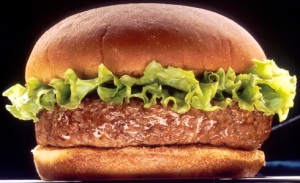Foods in 1900-1914
If the late 19th century is called by the Gilded Age, the early 20th century is called by the Progressive Era. During these two time periods, the industry of America had increased rapidly. Accordingly, the foreign immigrants were pouring into the U.S. Mostly Chinese and Europeans, the immigrants had come to North America to achieve their American Dreams. However, despite the several Western states, the European immigrant workers were common in America. Contrasting to the Americans’ expectations, the European workers did not want to be imbued with the new styles of living in America. Instead, they kept their cultural distinctiveness by living with the same peoples, and kept their traditional foods. In fact, those traditional foods were not only kept by the immigrants, but influenced the history of food in America profoundly.
It is within bounds to say that Hamburgers and hot dogs are representing foods of the Americanization. However, both of those foods were not originated in America. Of course, the hamburgers of today were changed by Americans partially, but the origin of this food ascends to the 15th century, Germany. Ships from the German port of Hamburg, the German merchants traded with Russian ports. The minced meats, which were called by “Tartare Steaks” during that time and eaten raw, were a vestige of the Mongolian invasion in Europe. Soon, the German merchants of Hamburg brought and began to serve with the grilled version of them. This special type of food later brought to America by the German immigrants and became popular by Americans as well as hot dogs. Hot dog sausages are also called by ‘frankfurter’, which is a city of Germany. When these two traditional foods came brought to America by the German immigrants, there was a common fact. They were changed, by Americans, to be more portable. This fact reflects that the people, who were living during 1900-1914, were very busy and the overall milieu of the era was very industrialized and fast-moving.
 The Hamburg steaks and Frankfurter sausages were sold to Americans during the late 1800s. They were not like the hamburgers and hotdogs that are selling today. The early restaurants served the ground beef petty, which is the Hamburg steak, without the French fries or buns. Hence, the hot dogs were served without the buns and called by the ‘red hots’. In 1901, Bert W. Gary of Clarinda, Iowa started to serve Hamburg steaks on a bun and it started to become popular between the middle and lower class people. In 1903, Adolf Gehring, who sells foods and drinks at the ball games, was sold out of his foods and drinks; therefore he bought some long dinner rolls and sausages. He put the sausages on the rolls and offered to his customers and one of them called it by a ‘Hot Dog’ and, everyone in the crowd was soon calling the sausage sandwiches by hot dogs. The buns were invented for the sake of portability. Unlike the hamburgers and hotdogs of today, the hamburgers and hot dogs during 1900-1914 were not very harmful. However, since many of the restaurants started to serve them with massive productions, they added preservatives on the beef patties, and lowered the content of beef for more profits.
The Hamburg steaks and Frankfurter sausages were sold to Americans during the late 1800s. They were not like the hamburgers and hotdogs that are selling today. The early restaurants served the ground beef petty, which is the Hamburg steak, without the French fries or buns. Hence, the hot dogs were served without the buns and called by the ‘red hots’. In 1901, Bert W. Gary of Clarinda, Iowa started to serve Hamburg steaks on a bun and it started to become popular between the middle and lower class people. In 1903, Adolf Gehring, who sells foods and drinks at the ball games, was sold out of his foods and drinks; therefore he bought some long dinner rolls and sausages. He put the sausages on the rolls and offered to his customers and one of them called it by a ‘Hot Dog’ and, everyone in the crowd was soon calling the sausage sandwiches by hot dogs. The buns were invented for the sake of portability. Unlike the hamburgers and hotdogs of today, the hamburgers and hot dogs during 1900-1914 were not very harmful. However, since many of the restaurants started to serve them with massive productions, they added preservatives on the beef patties, and lowered the content of beef for more profits.
During the 1900-1914, the Progressive Era, the major cities in America were urbanized. The continuous increasing numbers of immigrants solved the labor shortages among the factories. However, the laborers, especially the immigrated workers, were not in the positions of lying down on their jobs. Many corruptions among the government officials and factory owners caused more poverty for the middle and lower class people, who were mostly immigrants. Therefore, they welcomed the hamburgers and hotdogs, which were really cheap. Nowadays, modern people believe that the quality of the people’s daily lives increased remarkably, and the society had improved too. However, the hamburgers and hotdogs are still popular in today, plus the varieties of these foods have been increased and improved conspicuously. According to this social phenomenon, it is a plain fact that there are still gaps between the rich and the poor. During 1900-1914, the Progressives struggled to rectify the society, but maybe the today’s United States needs another progressive era.
http://whatscookingamerica.net/History/HotDog/HDIndex.htm
http://whatscookingamerica.net/History/HamburgerHistory.htm
http://www.digitalhistory.uh.edu/historyonline/food.cfm
-Chris Kim-

10.